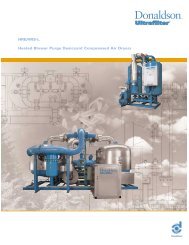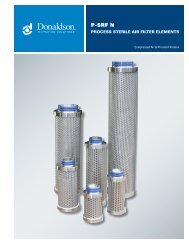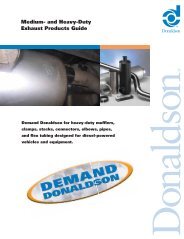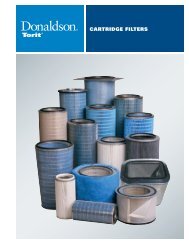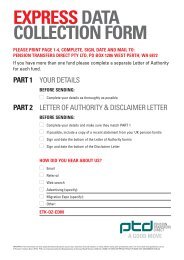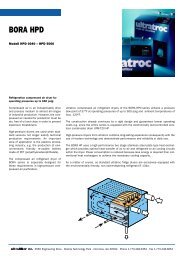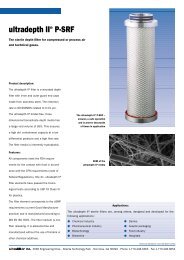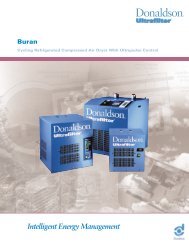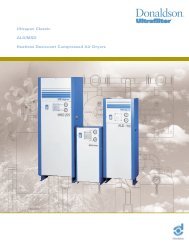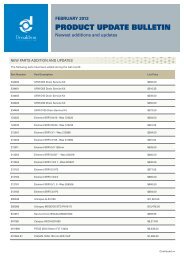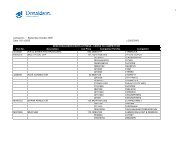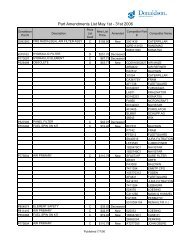Donaldson D-Fog - odms.net.au
Donaldson D-Fog - odms.net.au
Donaldson D-Fog - odms.net.au
You also want an ePaper? Increase the reach of your titles
YUMPU automatically turns print PDFs into web optimized ePapers that Google loves.
<strong>Donaldson</strong> D-<strong>Fog</strong><br />
fog removal solution<br />
The following excerpts from the Microphysical Properties of <strong>Fog</strong> at Otis AFB<br />
report are relevant to the parameters used in the D-<strong>Fog</strong> program:<br />
“Describing a typical droplet spectrum for (advection) fogs is difficult since no<br />
two droplet spectra are alike. Droplet size spectra vary not only from one fog<br />
episode to another, but also during the life of a particular fog and with height<br />
above the ground.”<br />
“The common feature of…samples taken, is, without exception, the high<br />
concentration of particles below 2.5 "m: that is, apparently, the result of inactive<br />
or haze nuclei.”<br />
“…a typical or mean spectrum of the data collected. It is characterized by a<br />
primary mode between 0.5 and 2.0 "m, a secondary mode or plate<strong>au</strong> between 5<br />
and 10 "m, and a plate<strong>au</strong> between 15 and 30 "m.”<br />
“The distribution of liquid water....is bimodal with peaks at about 10 "m and 30<br />
"m.”<br />
Since <strong>Donaldson</strong>’s standard mist eliminator efficiency is very high on droplets 55<br />
"m and larger, the D-<strong>Fog</strong> accessory and operating plan is designed to address the<br />
effects of droplets smaller than 55 "m.<br />
B. Influence of Humidity and Moisture on Filtration Media<br />
All of <strong>Donaldson</strong>’s moisture resistant filter media used for gas turbine air inlet<br />
filtration are very resistant to both high humidity and water droplets. The<br />
synthetic media has a strong resistance to water by virtue of the fibers being<br />
non-absorbent. The Duratek media undergoes a resin treatment that enhances<br />
its resistance to water. The Spider-Web ® fine fiber treatment is also a material that<br />
does not absorb moisture.<br />
Laboratory tests on clean filter elements indicate only a negligible increase in<br />
restriction (0.1" to 0.2") by introducing high humidity to <strong>Donaldson</strong> elements,<br />
even after several hours of operation. A measureable, but tolerable, rise in<br />
restriction was achieved by feeding an artificially excessive concentration of fog --<br />
up to 2" after an extended operating time (7 hours.) This gain in restriction is<br />
due to particulate loading of the fog droplets. The restriction on the elements<br />
decreases promptly when the fog challenge is removed.<br />
C. Influence of Humidity and Moisture on Contaminant<br />
Contaminants have varying degrees of sensitivity with respect to moisture. As<br />
they are pieces of their bulk parent components, it is believed that their behavior<br />
with respect to humidity and moisture will be characteristic of their bulk parent<br />
forms, i.e. clay and cement dusts will bind when mixed with water, salts will<br />
deliquesce in the presence of humidity, etc. The exact behavior of contaminants<br />
becomes very complex to predict when they combine with materials of other<br />
families such as in the case of the dust cake on an air filter.<br />
page 4<br />
Many of these environmental contaminants will expand, or swell when exposed<br />
to moisture. When they are present in the dust cake on a filter element, the<br />
swelling of these contaminants reduces the free area available for air to pass




